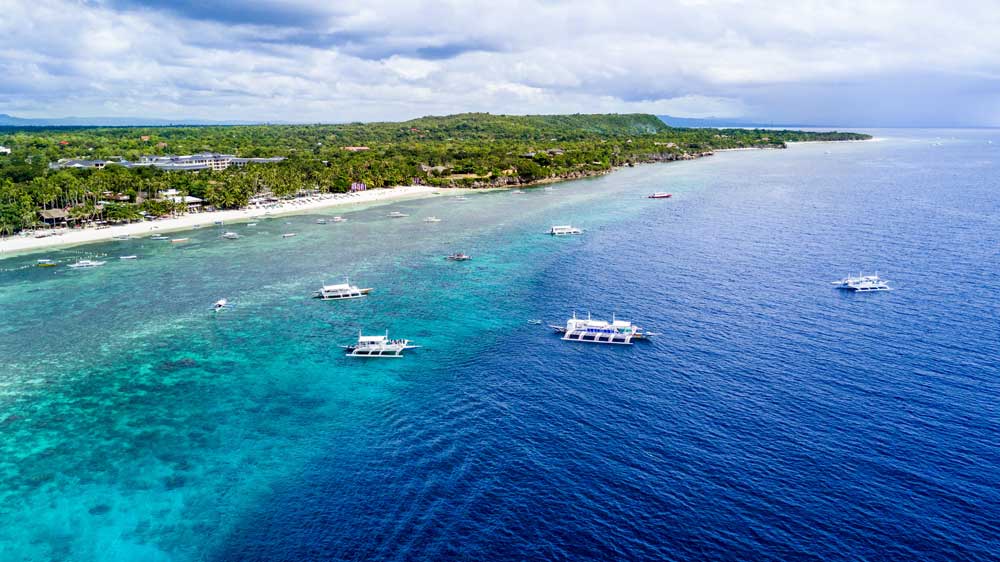
Tauche ein in das Tauchsafari-Erlebnis von Visayas auf den Philippinen
Your adventure on a liveaboard will unveil the wonders beneath the waves, revealing a world of vibrant coral gardens, mysterious wrecks, and schools of whimsical fish dancing in the gentle currents. The Visayas region has a rich history, with each island telling tales of the ancient civilizations that once thrived here. The blend of cultural heritage and natural beauty creates a unique backdrop to your underwater exploration.
Über Visayas Liveaboard
From the elusive thresher sharks of Malapascua to the mesmerizing sardine runs of Moalboal, the Visayas promises an unforgettable diving adventure amidst the heart of the Philippines’ marine biodiversity.
The Visayas region in the Philippines is a diver's paradise, offering a range of unique diving experiences across its various sites. Best experienced with a Visayas liveaboard, here's a closer look at some of the prime diving destinations in this region:
Malapascua: Known for its thresher shark encounters, Malapascua Island is a jewel in the Visayas diving crown. Apart from thresher sharks, divers also frequently spot manta rays, hammerhead sharks, and a rich variety of smaller marine creatures. The dive sites here cater to all levels of divers, with Monad Shoal being the most famous for shark sightings.
Insel Pescador (Moalboal): A marine park located near Moalboal, Pescador Island is celebrated for its vibrant coral walls and abundant marine life. The Cathedral, a cavern dive site, is one of the highlights here. The island is also home to schools of sardines, frogfish, and occasionally, whitetip sharks.
Sumilon Island: Known for its crystal clear waters, Sumilon Island offers stunning coral landscapes and a variety of marine life including reef sharks, rays, and a multitude of fish species. The island also has a marine sanctuary which has greatly helped in preserving the local marine ecosystem.
Moalboal: Neben der Insel Pescador ist Moalboal selbst ein Tauchzentrum in Philippinen known for its sardine runs. The sight of millions of sardines swirling together in unison is a spectacle not to be missed. There are also numerous dive sites here suitable for all levels of divers, featuring beautiful coral gardens and diverse marine life.
Apo-Insel (Negros): Leading the diving scene in Negros, Apo Island is a protected marine sanctuary. It's a haven for divers, boasting healthy coral reefs teeming with colorful marine life. Popular dive sites include Coconut Point and Chapel Point, each offering unique underwater landscapes and a variety of marine species.
Bohol: The waters around Bohol are a playground for divers. Sites like Alona Beach and Panglao Island offer a mixture of wall, drift, and macro diving. The area is rich in coral gardens, small caves, and overhangs, housing a diverse range of marine life from nudibranchs to reef sharks.
Balicasag-Insel: A small island off the coast of Bohol, Balicasag is famed for its wall dives. The island’s steep walls are adorned with beautiful corals and are home to a variety of marine species including turtles, barracudas, and jacks. Diver's Heaven and Black Forest are among the popular dive sites here.
Wann sollte man nach Visayas reisen?
The best time to visit the Visayas region in the Philippines for diving would be outside the typhoon season and the rainiest months, which occur from late November through February.
Während dieser Zeit, insbesondere von Dezember bis Februar, herrscht in den östlichen Visayas, einschließlich Cebu, Bohol und Leyte, aufgrund der Amihan-Saison (Nordost-Monsun), die starke Regenfälle mit sich bringt, ein feuchtes Klima, das insbesondere die Tauchplätze in Southern Leyte betrifft. Taifune kommen auch von November bis Januar häufig vor und betreffen insbesondere Leyte und den nördlichen Teil von Cebu.
The waters can get rough during either the northeast or southwest monsoon (Habagat) as winds stir up the waves, potentially affecting the diving conditions. However, it's mentioned that dive trips are still recommended year-round as dive operators are knowledgeable about the seasonal variations and can guide divers to sheltered areas offering great diving experiences despite the prevailing weather conditions.
Für ein berechenbareres und angenehmeres Taucherlebnis könnte die Planung Ihres Besuchs zwischen März und Anfang November ideal sein. Insbesondere verlagern einige Tauchsafaris ihren Betrieb auf Tubbataha von März bis Juni, wobei die kürzere Tauchsaison dort genutzt wird, was auch darauf hindeutet, dass diese Zeit für das Tauchen in der Region Visayas günstig ist.




